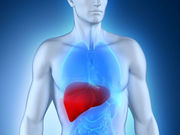Better diagnostic performance for MRI- versus TE-based measurements for liver fibrosis, steatosis
MONDAY, March 7, 2016 (HealthDay News) — For patients with nonalcoholic fatty liver disease (NAFLD), magnetic resonance imaging (MRI) measurements are more accurate than transient elastography (TE) for identifying liver fibrosis and steatosis, according to a study published in the March issue of Gastroenterology.
Kento Imajo, M.D., from the Yokohama City University Graduate School of Medicine in Japan, and colleagues performed a cross-sectional study of 142 patients with NAFLD (identified by liver biopsy) and 10 comparable subjects without NAFLD. Participants were evaluated by TE, including controlled attenuation parameter (CAP) measurements, and MRI using magnetic resonance elastography (MRE) and proton density fat fraction (PDFF) techniques
The researchers found that for patients with fibrosis stage ≥2, TE identified them with an area under the receiver operating characteristic (AUROC) curve value of 0.82, compared with 0.91 for patients identified by MRE (P = 0.001). For patients with hepatic steatosis grade ≥2, TE-based CAP measurements identified them with an AUROC curve value of 0.73, compared with 0.90 for PDFF methods (P < 0.001). For identification of nonalcoholic steatohepatitis, serum keratin 18 fragments or alanine aminotransferase measurements did not add value to TE or MRI.
“MRE and PDFF methods have higher diagnostic performance in noninvasive detection of liver fibrosis and steatosis in patients with NAFLD than TE and CAP methods,” the authors write.
Copyright © 2016 HealthDay. All rights reserved.








